Big gaps between brickmold and brick veneer -NEW PHOTOS ATTACHED
Hi all,
I’m replacing some rotted brickmold on my old (1920’s) frame and brick veneer house and trying to figure out how to best caulk/fill the joint between the brick and wood.
The brick is rough clinker brick. The veneer (properly) sits 1″ or so off the sheathing to allow for ventilation, but in some places there are large (say 3/4″) gaps between the brickmold and the brick, mostly where mortar has chipped out at the back of the joint or where the irregular bricks just leaves a bigger gap..
Previous owners slopped some sort of hard putty and gobs of caulk in areas where there are large gaps. Looked like crap and the joints had failed in many places so I painstakingly removed it.
I’m thinking here must be a better way… Repoint?
I’ve removed the old brickmold. What’s next? Brickmold first, then mortar? Pack with mortar, then brickmold? Tools and techiniques? A grout bag, maybe?
Or should I be caulking?
Any help would be appreciated.
Jim
PS – New photos attached. The first two show closeups of the door frame with the brick mold removed, (door frame is primed brown) highlighting the gap behind the brick and the fact that it does not return to the wall. The second also shows what looks like an old attempt to repoint behind the brick.The third shows the gaps with an old piece of the brick mold held in place and the fact that there are still gaps to be filled. The fourth shows the shape of the head of the opening. The fifth shows another larger gap, about 3/4″ in size.
Any new ideas?
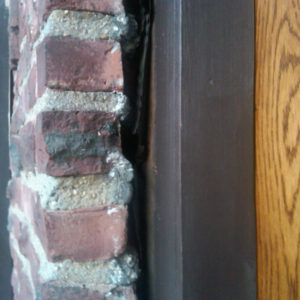
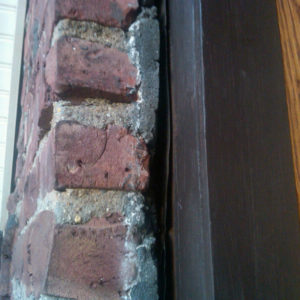
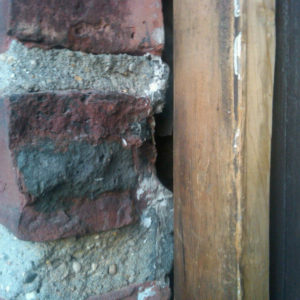
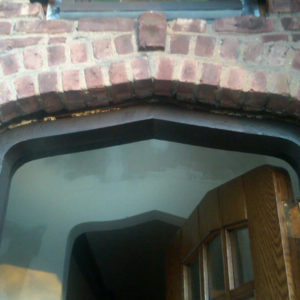
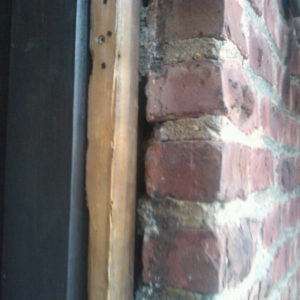



















Replies
Jim
Not being able to see it from here.........
If there were a couple "bad" spots I'd use backer rod first to put a stop to hold the caulk and then use urethane caulk to do a nice job between the brick and just installed molding. Use the caulk to fake the bad spots. There's a "sanded" type made for morter repair-Tremco sealants is a good one to look for-Dymonic is one of there's. The other more sandy one they have-the name escapes me at this time. Limestone (the color) dries a light grey. They might have a darker grey also.
If there are alot of places where you've got morter missing, I'd repoint.
As for the best method for that.................a grout bag takes two hands. You've got to give the morter somewhere to both stick and stop-so it doesn't fall out and you keep plugging more in. With two hands on the bag, you've got none to stop the morter.
You'll end up with a pointing trowell and the fingers on your other hand holding it from the back.
One thing that might work would be to take a pc of cardboard or even a strip of masonite-. Cram it in there flat against the back of the brick and figure a way to hold it in position. Now you've got a way to stop the morter from falling in. If you could grease it up so morter doesn't stick to it, all the better.
Best of luck.
If the gap is oversize all around, and you already have the brick mold off, I'd replace with wider brick mold, to get things down to 3/8" or less. While the brick mold is off I'd point the really bad spots, then stuff large foam backer rod into the gap, then install the brick mold. (Be sure you pre-prime the brick mold on all sides with the best quality exterior primer you can find before installing.) Where the remaining gap is wider than about 3/16" stuff in more (narrower) backer rod, then caulk.
You DON"T want to try to fill the gap with mortar -- you need 1/8" to 1/4" gap to caulk properly, and mortar alone does not seal and does not have the "give" needed to stay tight with the wood. You also DON'T want to "stuff" the gap with caulk -- use the backer rod so that the caulk is never more than 1/4" deep (and preferably a bit less).
Do it right and the job will last 20 years easy.
Dan
I think the problem is with the brick returns back to the sheeting. So the brick mold is not too narrow but not thick enough.
Now that I write that I can come up with another solution.
B/4 reapplying new brickmold, he should extend the window jamb out so now the usual thickness brickmold (been the same for a long time) will cover the returns. Now, no need to point the real bad spots where the brick is cut too short.
I'm assuming these are halves cut and turned to return.
maybe.
Yep, if the brick is proud of
Yep, if the brick is too proud of the brick mold he can install shim strips behind the mold. Also, even if he uses stock mold (which in my experience has changed size at least once in the past 35 years) he can cut it a little longer and "reveal" a little more on the window jambs to help close up any gaps.
All together now -- everyone click "Inappropriate".
Thanks for all the responses, guys. Sorry it took me a while to get back.
The opening in question is a tudor-arched door opening.
I saved and cleaned up the 2 head pieces, but am replacing the legs. The old stuff was just 5/4 stock ripped to 1 7/8" wide, so that's what I plan to use.
I initially thought the idea of "thickening" the brick mold made sense, but if I do this then the legs will stand proud of the horns on the oak threshold.
How about using some expansive foam (Great Stuff) as a backer for the pointing?
The brick does not return back to the sheathing. The only thing that covers the gap between the sheathing and the brick is the brick mold.
Scribing is a good idea that I hadn't thought of, although I already ripped the 5/4 stock to the same width as the old. Would have to buy new for this approach to work...
Will try to get a photo tonight.
New Photos posted above
Any other thoughts?
Not sure that'll work on the bottom at all, as the front face of the thicker brick mold would stick out beyond the front face of the oak threshold...
A plinth would only make matters worse, wouldn't it? Or are you suggesting that I "encase" the horns with the plinth, somehow?
encase the horns?
Cut 'em off and run the plinth down past and next to the threshold...................
Use something that'll take the abuse of moisture wicking, sitting and constant. Good use for stone or Azek.
Great solution - will do
Thanks!
Jim
It's worked for me in moisture areas. But it you use stone, seal the hell out of any wood that it comes in contact with it.
Here, limestone is the stone of choice for underthresholds, treads for steps, etc.. A real moisture holder.
Interested in the solution. My GC’s workers decided the brick molding did fit close enough so they started chiseling out brick … and was trying to put the molding behind the brick. Now I have a large hole gap between to brick and the brick molding… larger than before they chiseled out the brick. I thought they just needed a 1/2 to 1 inch thicker brick molding and now that is impossible. What is the solution?
My cousin … and window anc door contractor in another state said they miss measured the thickness anc should have re-ordered the door or added 1.5 of additional molding … this was before they started chiseling out brick … I have no idea what they plan to do but it looks like they made a bigger problem rather than fix the original minor problem.
look at Mike Sloggatt for some inspiration; not quite the same he has masonry veneer over wood and you likely have masonry mass wall construction.
https://www.finehomebuilding.com/project-guides/windows-doors/new-window-in-a-brick-house
try to tie into the felt paper that appears around the opening with some peel and stick or with some metal flashing and sealant. get this in place and do whatever you can to work with the drainage plane to control water and direct it out.
chipping masonry on a 100 year old structure to install $200 of trim? you need a good mason before you need a carpenter. they should be using a restoration mortar [1:1:5 PCC/hydrated lime/sand for instance] instead of the type S mortar that appears they used in the past.
Then you can install brick mold -- Seems like you need custom milled stock. certainly possible, but looks like beyond the skill-set of the crew you have now.